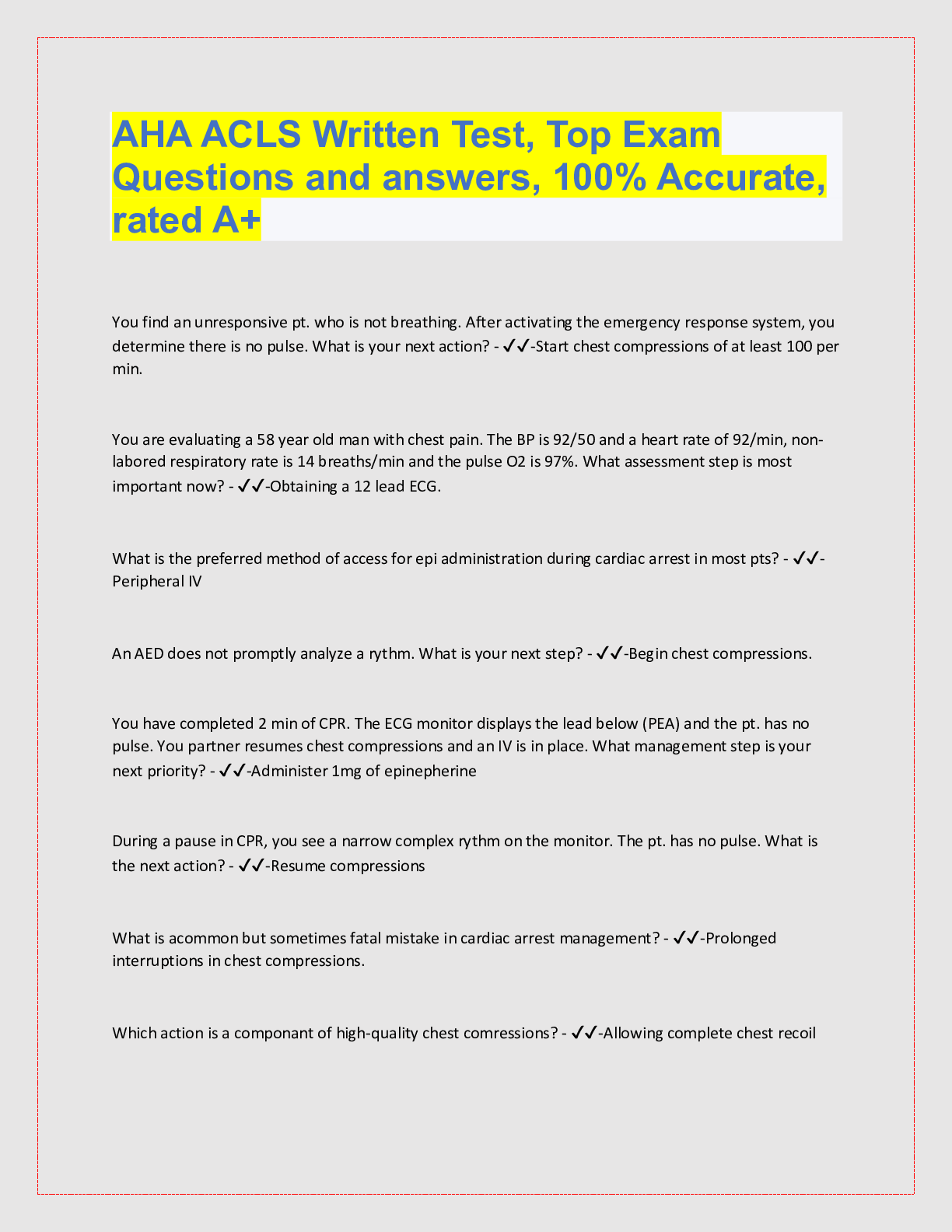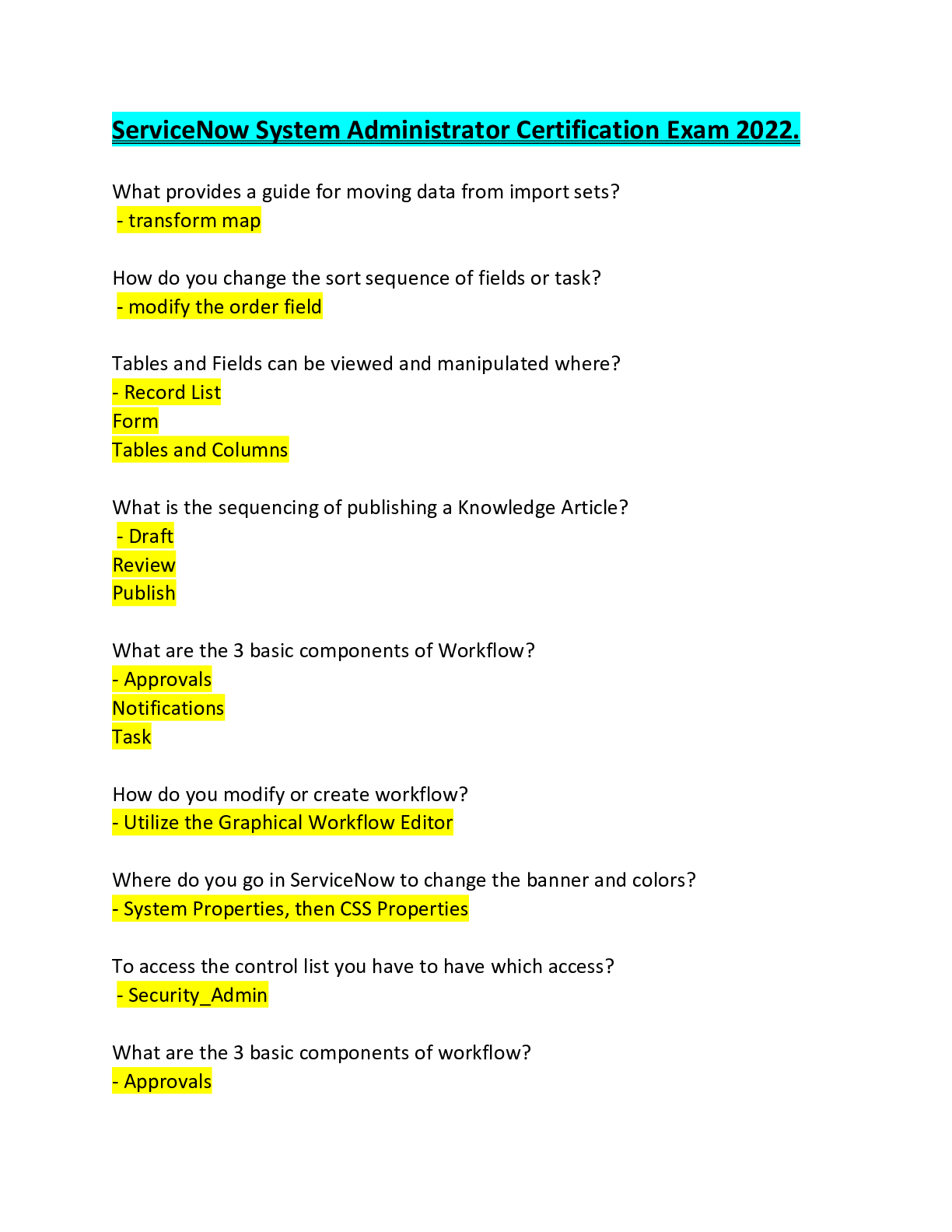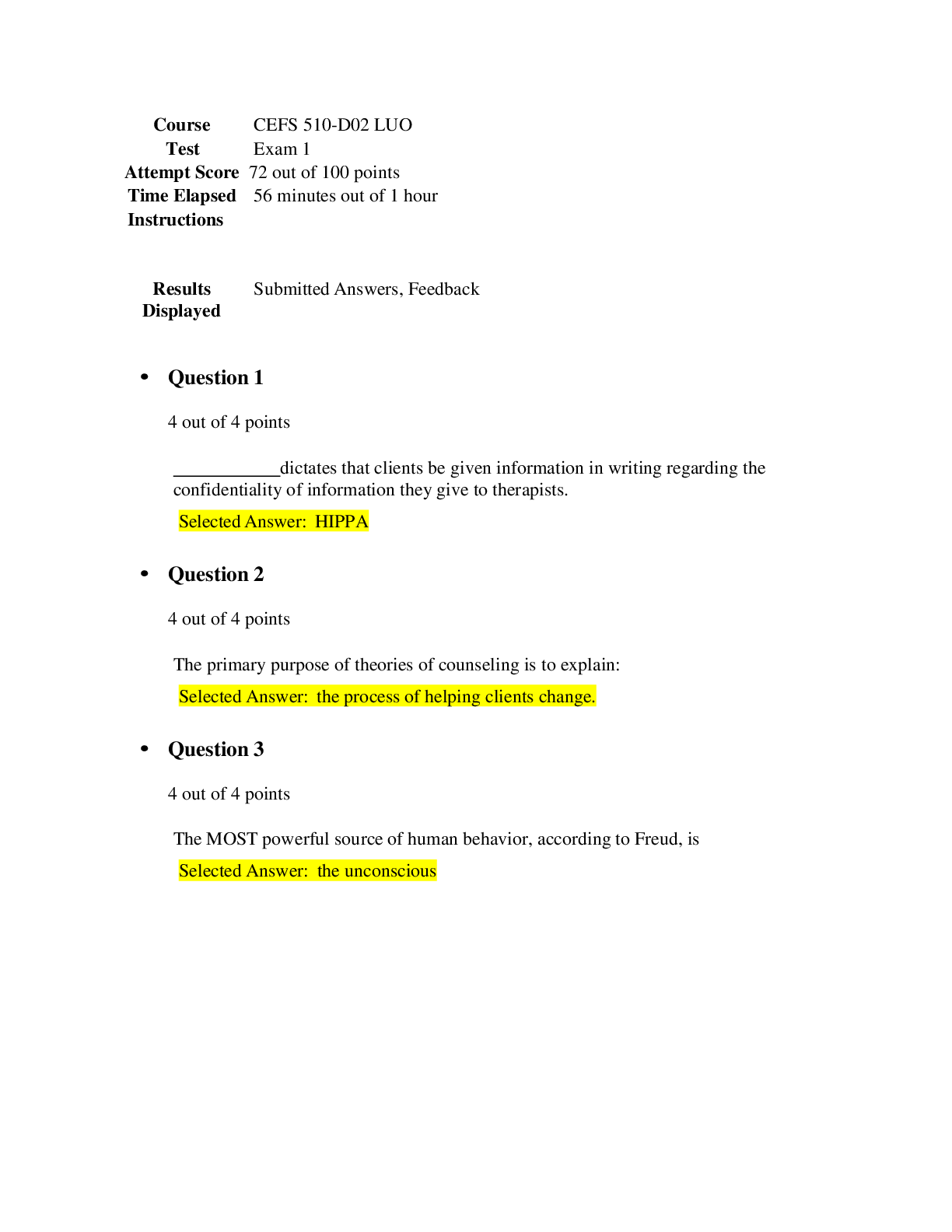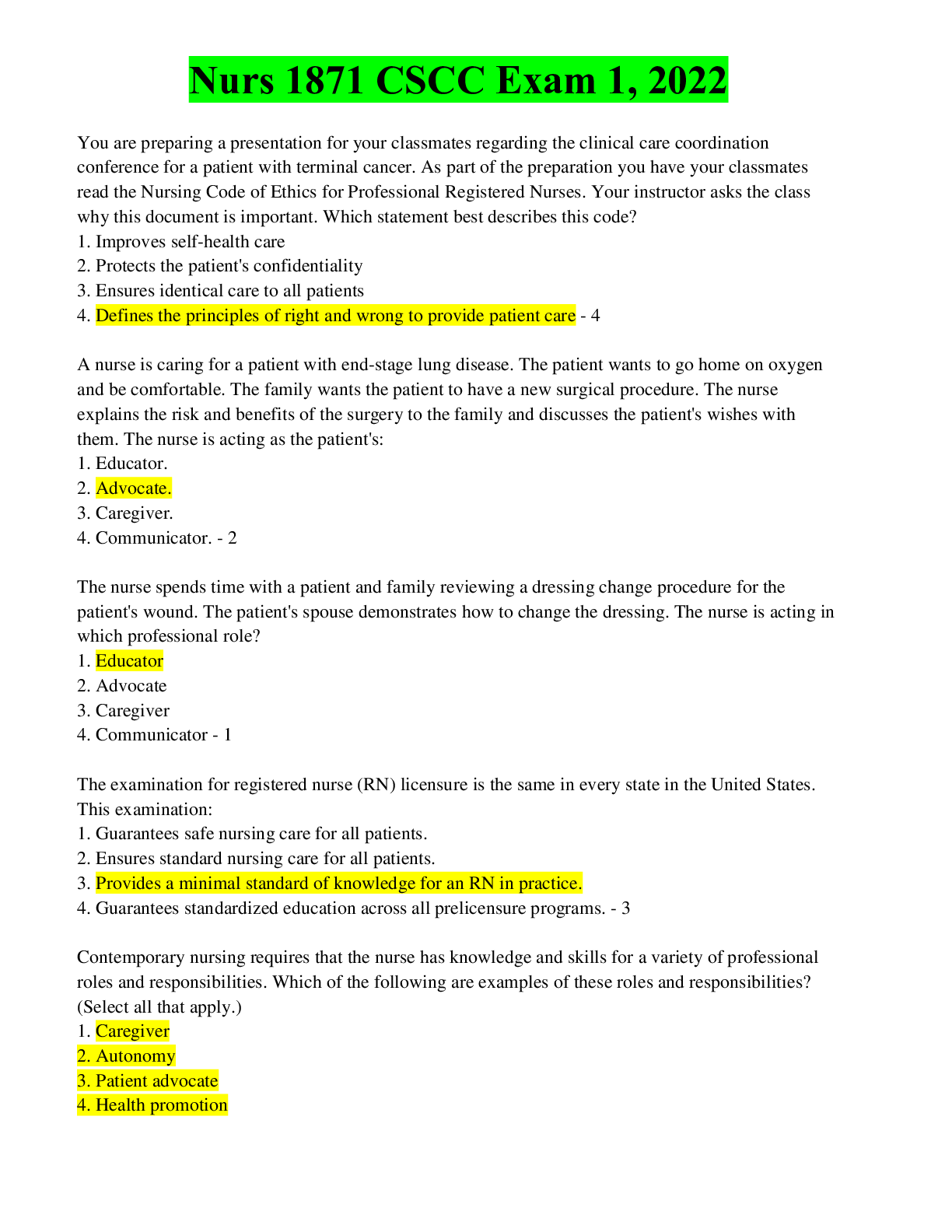University Of Connecticut BIOL 1108 Exam 1 (answered)
Document Content and Description Below
Biology 1108, Exam 1 1. An organelle that is responsible for the red or orange color of fruits such as peppers and tomatoes is the . a chromoplast b. chromosome c. amyloplast d. phelloderm e.... chloroplast 2. What substance is found in secondary cell walls that makes them waterproof and very strong? a lignin b. protein c. DNA d. pectin e. anthocyanin 3. Carnivory has evolved several times independently in plants that live in acidic bog habitats. These carnivorous plants use modified to capture insects, which are then digested for their . a. stems | carbon b. steles | oxygen c. roots | water d. leaves | carbon e leaves | nitrogen 4. Which of the following series shows the order in which structures would be encountered if you started from outside a plant cell and moved into the cell in a direction that would take you into the large central vacuole? a primary cell wall | secondary cell wall | cell membrane ! cytoplasm b. cytoplasm | cell membrane | primary cell wall | secondary cell wall c. cytoplasm | primary cell wall | secondary cell wall | cell membrane d. secondary cell wall | primary cell wall | cell membrane | cytoplasm e. cytoplasm | cell membrane | secondary cell wall | primary cell wall 5. Which of the following cell types would never occur in secondary xylem tissue? a. sclerenchyma fiber b. parenchyna c. vessel element d. tracheid e companion cell 6. A complex tissue that consists of cells that are living at maturity and whose function is food transport is . a phloem b. parenchyma c. collenchyma d. xylem e. sclerenchyma 7. The best description of the shoot shown in Figure 1 is: a. compound oppositely-arranged leaves b. simple alternately-arranged leaves c. compound alternately-arranged leaves d simple oppositely-arranged leaves 8. The vascular cambium separates from a. springwood | summerwood b wood | bark c. cork | phelloderm d. heartwood | sapwood e. inner bark | outer bark 9. Which of the following is a meristematic tissue that primarily increases the length of a stem? a shoot apical meristem SAM) b. periderm c. root apical meristem RAM) d. vascular cambium e. cork cambium 10. Which of the following forces all substances entering the vascular tissue of a root to pass through an endodermal cell membrane? a. guard cells b Casparian strip c. pericycle d. phelloderm e. companion cell 11. Vascular bundles in eudicots in a cross-section of a stem) , which contrasts with monocot stems in which vascular bundles a. are scattered | form a ring b form a ring | are scattered c. form a cross-shaped pattern in the center | are scattered d. form a cross-shaped pattern in the center | form a ring 12. Which of the following is an underground stem? a fern rhizome b. cactus cladophyll c. pea tendril d. strawberry stolon e. poinsettia bract 13. Suppose you place a stalk of celery in a very salty solution. The cells of the celery are with respect to the salty water, and this will result in a net movement of water the cells of the celery. a. hypotonic | into b. isotonic | out of c. hypertonic | into d. hypertonic | out of e hypotonic | out of 14. Two containers are connected by a membrane that allows only water to pass. The water potential in container A is S = 1:5 MPa and P = 0:5 MPa, and the water potential in container B is S = 0:5 MPa and P = 0:5 MPa. Which of the following statements best describes the flow of water between these two containers? a. water molecules will move in both directions, but there will be a net flow of water from A to B b. water molecules will move only from container A to container B c. water molecules will move in both directions, but there will be a net flow of water from B to A d water molecules will move in both directions, and there will be no net flow of water in either direction e. water molecules will move only from container B to container A 15. Assuming that a tree is actively transpiring, what would be the most likely water potentials along the path from root to atmosphere? a. roots: -10 → xylem: -1.5 → leaf: -0.8 → atmosphere: -0.5 b. roots: +10 → xylem: +1.5 → leaf: +0.8 → atmosphere: +0.5 c. roots: +0.5 → xylem: +0.8 → leaf: +1.5 → atmosphere: +10 d roots: -0.5 → xylem: -0.8 → leaf: -1.5 → atmosphere: -10 16. Which relative humidity would result in no net loss of water from the plant by transpiration? a. 0% b. 20% c. 50% d 100% 17. Which of the following statements about cohesion of water is not true? a. cohesion results from the attraction of water molecules to each other b. cohesion is the reason why you can draw water into your mouth from a glass using a straw c. without cohesion, water would not move up the xylem to replace water lost from leaves d cohesion is responsible for the opening and closing of stomata in leaves 18. Suppose you are thinking of starting a business called GroLite in which you would sell brightly colored light bulbs for purposes of growing plants indoors during the winter months. Of the following colors chosen by your marketing manager, which would be the worst choice for such an endeavor? a. blue b. white c. red d green 19. Compared to blue light, red light is relatively because it has relatively wavelengths. a. high energy | short b. low energy | short c low energy | long d. high energy | long 20. Even after unloading its sucrose at a sink, a phloem sieve tube element is still hypertonic compared to an adjacent xylem vessel element, which contains almost pure water. Why then is there a net movement of water from the sieve tube element into the vessel element? a the xylem vessel element is under negative pressure due to transpiration b. the phloem sieve tube element is under negative pressure according to the pressure flow model c. the xylem vessel element is under positive pressure due to transpiration 21. The middle of all biological membranes is which means that a. hydrophilic | water is attracted to it b. hydrophobic | water is attracted to it c. hydrophilic | water is not attracted to it d hydrophobic | water is not attracted to it 22. The oxygen O2) produced by photosynthesis comes from the splitting up of a. carbon dioxide CO2) in the stroma b. carbon dioxide CO2) inside thylakoids c. hydrogen peroxide H2O2) inside thylakoids d water H2O) inside thylakoids e. water H2O) in the stroma 23. The electrons lost by the reaction center chlorophyll molecules in photosystem-I end up reducing to form . a. oxygen | water b. ATP | ADP c. NADPH | NADP+ d. ADP | ATP e NADP+ | NADPH 24. The term chemiosmosis refers to the net movement of from concentration across a semipermeable membrane. a. H2O j high to low b. H+ j low to high c H+ j high to low d. H2O j high to low 25. Crassulacean acid metabolism is used by many desert plants because it allows them to thus avoiding excessive water loss. a. _x carbon dioxide during the day and release it at night b open stomata at night rather than during the day c. perform the light reactions of photosynthesis at night d. eliminate the need for stomata 26. In C4 plants, malate is produced , then the malate is used to generate CO2 . a. while stomata are open at night | while stomata are closed during day b. in bundle sheath cells | in mesophyll cells c. while stomata are closed at night | while stomata are open during day d in mesophyll cells | in bundle sheath cells 27. The concentration of H+ protons) increases inside thylakoids during the light reactions of photosyn- thesis. This stored energy is used by to create as the protons move back to the stroma in much the same way water flowing downhill can be used to turn a turbine and generate electricity. a ATP synthase | ATP b. ATP synthase | ADP c. RuBisCO | PEP d. NADP+ reductase | NADPH e. NADP+ reductase | ATP 28. The RuBisCO enzyme and the other enzymes that carry out the Calvin cycle are located in the a. cell nucleus b. central vacuole of a cell c. cytosol cytoplasm outside the organelles) d. space between cells e chloroplast stroma 29. Plants exhibiting Kranz leaf anatomy are known as plants. a. CAM b. C3 c C4 d. carnivorous e. wreath 30. C4 plants avoid the photorespiration that plagues C3 plants by a. opening their stomates only at night, when the concentration of carbon dioxide in the air is higher b. inheriting from their ancestors a version of RuBisCO that does not mistake O2 for CO2 c. flooding RuBisCO with O2 so that CO2 only rarely enters the active site d flooding RuBisCO with CO2 so that O2 only rarely enters the active site 31. Starch grains in play a role in the response of plants. a. cells of stems | phototropism b. leaf cells | gravitropism c root cap cells | gravitropism d. leaf cells | nastic e. leaf cells | thigmotropism 32. Which of the following scientists performed experiments that first demonstrated that some substance is produced in the tips of grass coleoptiles but elicits a bending response to light some distance below the tip? a. Winslow Briggs b. Albert Einstein c Charles Darwin d. Frits Went e. Watson Crick 33. Which of the following is an effect of the hormone auxin? a. stimulation of the aleurone layer in germinating grass seeds b maintenance of dormancy in lateral buds while the tip of the shoot is intact c. signals stomata in leaves to close, stopping transpiration d. leaf abscission in deciduous trees in autumn e. development of lacunae in aquatic plants 34. Which of the following is an effect of the hormone abscisic acid? a. stimulation of the aleurone layer in germinating grass seeds b. leaf abscission in deciduous trees in autumn c. maintenance of dormancy in lateral buds while the tip of the shoot is intact d. development of lacunae in aquatic plants e signals stomata in leaves to close, stopping transpiration 35. The bacterium Agrobacterium tumefaciens inserts genes for the plant hormones and into plants, causing them to develop callus tissue a tumor) in which the bacterium lives. a. cytotoxin | cytokinin b. brassinosteroid | ethylene c. phytochrome | abscisic acid d. gibberellic acid | lignin e auxin | cytokinin 36. The parts labeled in Figure 2 are: X = , Y = . a. cotyledon | ATP synthase b. pith | vascular bundle c. starch grain | pericarp d. cortex | seed coat e endosperm | cotyledon d red | far red | Pr 37. When light passes through green leaves, more light is absorbed than , which causes the form of phytochrome to dominate in shaded seedlings. a. red | far red | Pfr b. far red | red | Pfr c. far red | red | Pr 38. Which of the following would fool a short day plant such as Poinsetting into flowering even if days are currently longer than their critical day length of 9 hours? a. exposure to an equal mixture of red and far red light during the middle of the night b. exposure to red light during the middle of the night c exposure to far red light during the middle of the night d. exposure to white light during the middle of the night 39. The type of cell division known as produces cells from a parent cell. a meiosis | haploid | diploid b. mitosis | haploid | diploid c. mitosis | diploid | haploid d. meiosis | diploid | haploid 40. An adult human is most comparable to in the plant life cycle. a. gamete b sporophyte c. spore d. gametophyte e. zygote [Show More]
Last updated: 2 years ago
Preview 1 out of 7 pages

Buy this document to get the full access instantly
Instant Download Access after purchase
Buy NowInstant download
We Accept:

Reviews( 0 )
$14.00
Can't find what you want? Try our AI powered Search
Document information
Connected school, study & course
About the document
Uploaded On
Feb 24, 2022
Number of pages
7
Written in
Additional information
This document has been written for:
Uploaded
Feb 24, 2022
Downloads
0
Views
180



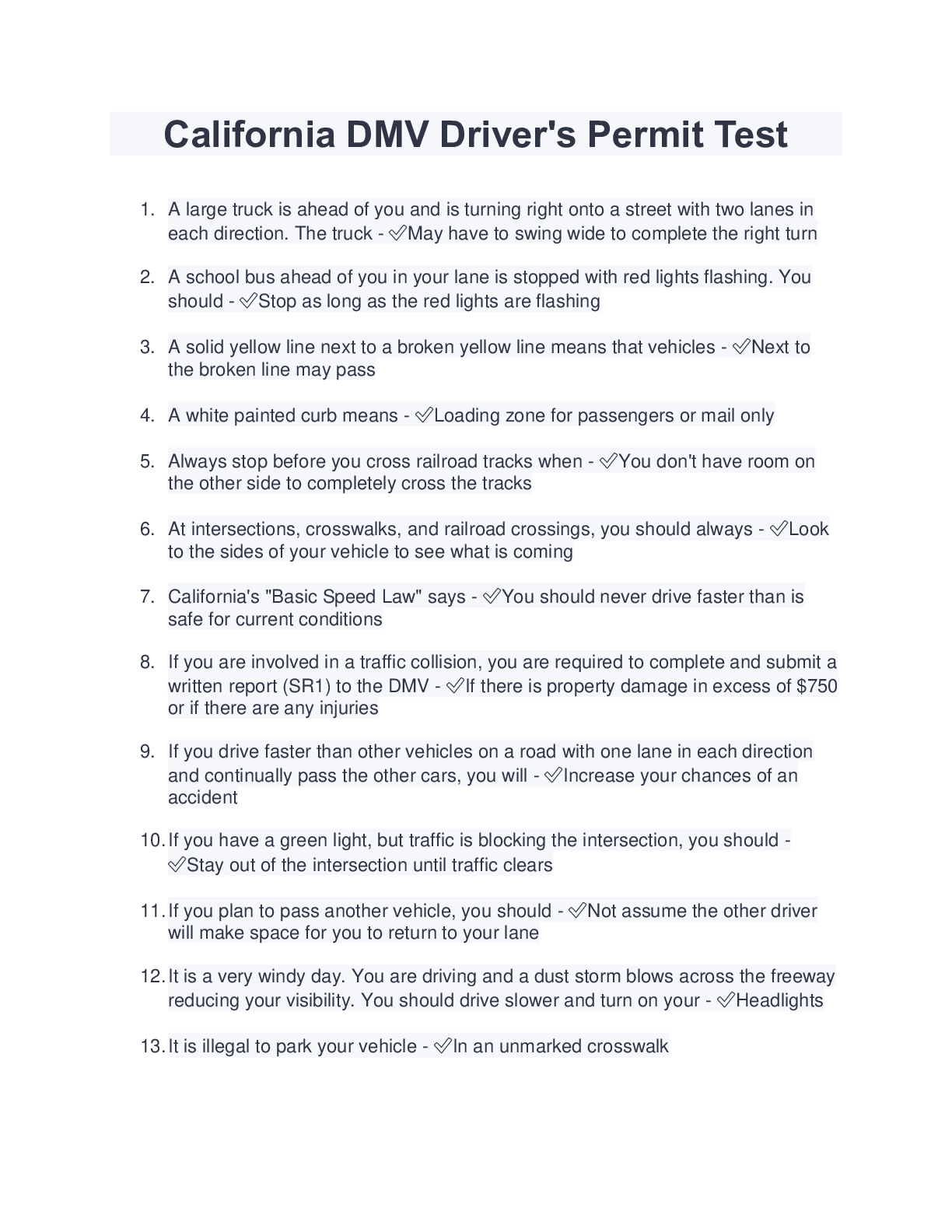

.png)

